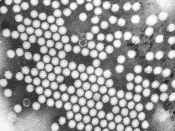Castro, Christina M & W 7:15 October 15, 2014 Castro, Christina M & W 7:15 October 15, 2014
Polio
"Polio or poliomyelitis is a disease caused by poliovirus. It can cause lifelong paralysis and it can be deadly" (Centers for Disease Control and Prevention). While a plague to the human race for centuries, polio was never the devastating curse that other diseases, such as bubonic plague and smallpox, were. Then, in the early 20th century, polio cases were on the rise, and the largest outbreak of the disease ever seen began. It is from this large outbreak that our dread of polio largely comes from. From this outbreak, we have gotten the devastating images of children in wheelchairs and iron lungs, paralyzed from the ravages of polio, some never to walk again. And it is this outbreak of polio that led to the tremendous push from Western medicine to eradicate it once and for all.
According to the World Health Organization, Polio mainly affects children under 5 years of age. One in 200 infections leads to irreversible paralysis (WHO). Data provided by the CDC proves that among those paralyzed, 5% to 10% die when their breathing muscles become immobilized. "Cases have decreased by over 99% since 1988, from an estimated 350,000 cases then, to 406 reported cases in 2013" (CDC). While polio normally produces no symptoms, in the small percentage of cases that do produce symptoms, the disease can take three different forms: abortive polio, nonparalytic polio and paralytic polio. Abortive polio produces mild flu-like symptoms such as diarrhea, sore throat, fever, upper respiratory symptoms, and a general feeling of malaise. Nonparalytic polio produces neurological symptoms such as neck stiffness and sensitivity to light. Paralytic polio, the most devastating form of the disease, and also the least common.


